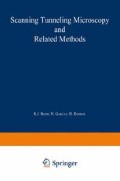Abstract
The pressure sensitivity of commercially available electret microphones is typically about 1 mV/µbar. A pressure of 1 µbar corresponds to a force of 10-6 N acting on the diaphragma. We show that, with suitable electronics, it is possible to detect — at the center of the diaphragm — even forces in the range of 10-9 N.
This sensitivity is in an interesting range, because the interaction forces occuring in standard tunneling microscopy between the tip and sample are of the same order of magnitude.
We present data of STM experiments under ambient air conditions on samples of graphite (H0P6) and of gold mounted at the center of the diaphragm. During the tunnel process the height of the tip was modulated (z-direction) with an amplitude of about 1 nm at a frequency of 2 kHz. We were able to measure the vibrations of the diaphragm caused by the periodic interaction forces between tip and sample.
In summary, we present a new method of simultaneous tunneling and force-microscopy.
Access this chapter
Tax calculation will be finalised at checkout
Purchases are for personal use only
Preview
Unable to display preview. Download preview PDF.
References
G. Binnig, H. Rohrer & E. Weibel; Phys.Rev.Lett. 49, 57 (1982).
P.K. Hansma & J. Tersoff; J. Appl. Phys. 61, R1 (1987).
G. Binning & C.F. Quate; Phys.Rev.Lett. 56, 930 (1982).
Y. Martin, B. Drake & P.K. Hansma; J. Appl. Phys. 61, 4723 (1987).
I.P. Batra & S. Ciraci; J. Vac. Sci. Technol., A. (Mar 1988) v. 6(2) p. 313–318.
U. Düring & J.K. Gimzewski; Phys.Rev.Lett. 57, 2403 (1986).
H. Yamada, T. Fuiji & K.Nakayama; J.Vac.Sci.Technol. A6(2).
J.M. Soler, M. Baro & N. Garcia; Phys.Rev.Lett. 57, 444 (1986).
G.M. Sessler, Topics in Applied Physics, Volume 33 (Springer Verlag New York 1980).
Author information
Authors and Affiliations
Editor information
Editors and Affiliations
Rights and permissions
Copyright information
© 1990 Springer Science+Business Media Dordrecht
About this chapter
Cite this chapter
Schreck, E., Knittel, J., Dransfeld, K. (1990). Electret-Condensor-Microphone used as a very sensitive Force Sensor. In: Behm, R.J., Garcia, N., Rohrer, H. (eds) Scanning Tunneling Microscopy and Related Methods. NATO ASI Series, vol 184. Springer, Dordrecht. https://doi.org/10.1007/978-94-015-7871-4_26
Download citation
DOI: https://doi.org/10.1007/978-94-015-7871-4_26
Publisher Name: Springer, Dordrecht
Print ISBN: 978-90-481-4075-6
Online ISBN: 978-94-015-7871-4
eBook Packages: Springer Book Archive

